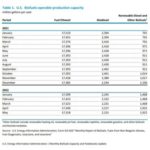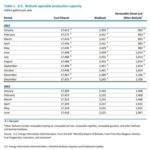Feedstock Variability: Causes, Consequences and Mitigation of Biological Degradation
Energy Disrupter
Researchers from the U.S. DOE’s Feedstock-Conversion Interface Consortium and Feedstock Logistics Program describe feedstock variability and why it matters for biorefinery operations.
ADVERTISEMENT
Feedstock variability is a general term for a broad range of biomass properties that can impact the efficient and continuous operation of a biorefinery. Corn stover, for example, can be considered waste or a coproduct feedstock of the corn grain industry. It usually costs less than dedicated energy crops.
However, even if corn stover is relatively cheap at the farm, collecting, transporting, and storing it creates logistical challenges that increase its cost as a feedstock. Importantly, how it is grown, harvested, and stored can impact quality. Take storage systems, for example. They are fundamental to feedstock supply logistics, as biomass harvest is seasonal, and biorefineries require a continuous, yearlong supply. But as is common when organic material is stored outdoors, feedstocks like stover bales break down over time due to biological degradation, also known as self-heating.
The U.S. Department of Energy Bioenergy Technologies Office convened the Feedstock-Conversion Interface Consortium in part to investigate such feedstock variability—both the challenges it presents and how companies might address it. In a series of planned articles, we will highlight our current understanding of the sources and impacts of feedstock variability on biomass conversion. In this initial article, we begin with the consequences of biological degradation on the quality of biofuel feedstocks. Degradation during storage can disrupt downstream processing and conversion yields. In some cases, it can mean procuring and processing additional feedstock to compensate for losses.
So, what do we know about biological degradation? And how can we mitigate it?
Longer Storage, More Degradation
Because agricultural residues are harvested seasonally, they must be stored over many months to ensure a continuous feedstock supply. Farmers often have only a short window to harvest corn stover, which is then stored for up to a year to supply a biorefinery. Depending on how it is stored and the environmental conditions to which it is exposed, the feedstock’s quality will degrade over time through natural decomposition.
That can translate into big impacts. Too much moisture in corn stover and other crop residues at harvest makes the materials less stable in storage and can harm processing performance. To avoid degradation, most feedstock logistics plans employ low-moisture baling to enable high-density handling and preserve dry matter. Storing baled corn stover fieldside is a cheap alternative to aggregated depot storage, but doesn’t eliminate the need for stack coverage and site selection to avoid the potential for standing water, and the need to clear the field for fall tillage. Fieldside storage can also eliminate an entire transportation and handling step by directly supplying the biorefinery. Of course, some biological degradation is unavoidable, but the moisture content of a bale during storage can dramatically influence its extent.
Critical Factor: Keeping Moisture Below 20%
When moisture content remains below 20%, bales lose minimal dry matter during storage (less than 10%). However, a threshold exists between 30% and 50% moisture content, above which extensive degradation can occur—causing upward of 30% dry matter loss.
Although not much can be done about the weather, the timing of corn stover harvest can reduce moisture and the risk of degradation. Using multipass harvest practices (i.e., rake and bale), farmers can leave corn stover in the field to dry to below 20% moisture content before baling. On the other hand, single-pass harvesting does not allow farmers to field dry corn stover, as it is baled simultaneously with the grain. In regions where farmers plant a winter crop, the stover may have limited time to dry and is usually removed soon after harvest.
Considering these factors, studies estimate that less than 40% of corn stover in the U.S. would typically be baled below 20% moisture content to prevent degradation. With sufficient moisture content—and depending on the oxygen conditions in the bale and its location in the stack—microbes can begin their work.
Fungi, Bacteria Drive Degradation
Microbes are the natural microbiota of soils and plants in the field, and are a critical component of the farm ecosystem. Biological degradation is driven by microbial respiration, a process that occurs within harvested materials and breaks down plant cell wall carbohydrates that are then lost as carbon dioxide. The effects of biological degradation are greatest when moisture, air (specifically O2), and degradable carbohydrates are readily available. These conditions support bacterial and fungal enzyme production and respiration (i.e., carbohydrate consumption), which produces heat that further accelerates biological activity up to temperatures as high as 140 degrees Fahrenheit.
Enzymatic degradation is driven by microbial enzymes specialized in degrading plant cell wall polymers. Some species of fungi and bacteria produce lignin-degrading enzymes. Many more secrete enzymes that break down hemicelluloses and cellulose. In doing so, the organisms often consume the available sugars, organic acids and oxidants, thus producing heat through respiration, which can impact the quality of the biomass. Biological heating results from an exothermic aerobic reaction—carbohydrate respiration—that can increase internal bale temperatures, even when outdoor temperatures are well below freezing. Sustained heating above about 90 degrees F has been shown to reduce the nutritional value of forages used for animal feed and may have a similar effect in corn stover feedstocks. One of the main results of these various forms of biological degradation is the composition of the stover changing, becoming enriched in glucan and lignin as hemicellulose is lost.
How Degraded Corn Stover Affects Processes Downstream
Dry matter loss is the most measurable, studied and likely critical driver of corn stover degradation. The causes of this loss in usable carbon are microbial enzymes and metabolism, which modify the lignin and degrade the pectins and hemicelluloses in the cell walls. In practice, this means less and lower-quality dry material. The result may be lower yields of both sugar and lignin monomers.
Another impactful change to degraded biomass is its accumulation of organic acids (primarily acetic acid), formed from the cleavage of acetyl groups from hemicellulose. Although these acids are easily removed, they accumulate on the surface of even the smallest bits of biomass. This changes their properties and impacts the effectiveness of pretreatment operations downstream, which may use acids or bases to loosen cell wall structure. For example, the biomass’s altered surface properties—including increased surface energy and hydrophilicity—inhibit its flowability through equipment.
Those are not all the changes biomass undergoes during degradation. In addition to changes to its surface, biomass becomes more brittle and generates more fine particles during milling and preprocessing operations, a result of modifications to cell wall polymers. Fine particles also contribute to poor flowability. Moreover, our studies have revealed that corn stover tissues—including leaves, husks, stalks, and cobs—respond differently to biological degradation. Each exhibit different physical and chemical changes. For example, leaves are especially susceptible and change dramatically, while cobs are practically immune to degradation impacts. These responses further exacerbate the variability of feedstock properties in degraded bales.
Preventing Degradation: Modified Storage Systems
There are multiple options for bale storage, and several that can reduce potential degradation, including indoor storage, cold storage, and oxygen and pH control storage (like pile and bale silage). Each requires additional processing steps and may be cost-effective in certain locations. In other cases, the additional costs are prohibitive for a biorefinery.
Still, covering the bales with tarps during outdoor storage in well-drained locations may just be the simplest and cheapest way to minimize feedstock loss to degradation. In addition, keeping corn stover bales dry with wraps, tarps or covered storage will reduce degradation during storage. According to the most recent analysis, doing so is a good value proposition, too.
If it needs processing anyway, accommodating degraded stover is challenging. However, industry can make several accommodations if degraded corn stover is going to be accepted into a biorefinery facility. Here are a few suggestions:
• Lower preprocessing intensity. Because degradation makes biomass more brittle, lowering preprocessing intensity for specific fractions can make particle size more uniform.
• Use milder acids. The severity of acidic pretreatment could be lowered because degraded material contains less hemicellulose and is already mildly acidic.
• Use stronger bases. For base pretreatments, the severity may need to be increased to counteract the neutralizing organic acids and modified lignin. However, for base treatments that target complete removal or “deacetylation” of hemicellulose and in degraded biomass, some acetyl groups are already solubilized.
Understanding how biological degradation changes biomass provides a clearer picture of the breadth of feedstock variability. That way, we can better engineer and accommodate materials with a range of storage moisture histories and still promote continuous operation.
But really—bales should just be kept dry, if possible.
Contact: Bryon S. Donohoe, Ph.D.
Senior Scientist, Biosciences Center
National Renewable Energy Laboratory
[email protected]
















